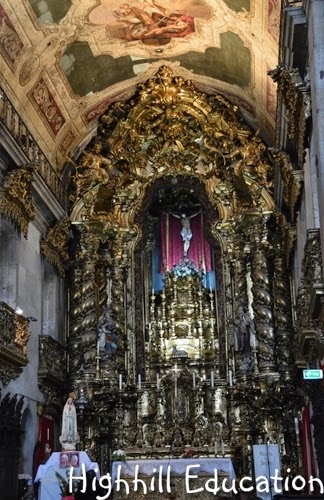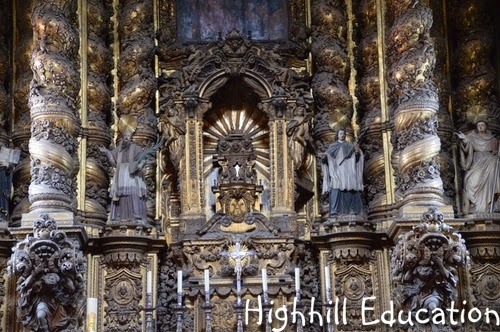Porto is a city famous for its wine. The mild climate along the Atlantic coast and convenient access to shipping enabled the industry to flourish and is a main export.
Prince Henry the Navigator
Prince Henry the Navigator lived in Porto about 30 years before Columbus sailed across the Atlantic. Since Prince Henry did much to support exploration Columbus first requested aid from Portugal for his voyages. Unfortunately, for him, Prince Henry had been gone for several decades and the new government leaders weren't so excited about Columbus' ideas. There is a nice statue dedicated to Henry the Navigator just outside the Palacio de Bolsa in the historic area of Porto.
Igreja do Carmo
Ingreja do Carmo was built in the 18th century.
The exterior was covered with a tiled panel.
The interior was richly carved and decorated with gold which is a characteristic of baroque/rococo architecture.
Se Cathedral
The Se Cathedral was built over the course of many years during the 11th, 12th and 13th centuries and located on the top of the hill overlooking the historic district of Porto.
Since construction began during the Romanesque period, the exterior is Romanesque which is characterized by the small windows, thick walls and decorative rose window.
But, since construction continued into the 13th century, flying buttress technology was used to extend the height of the cathedral and give support to the roof.
The interior was redone during the baroque period and therefor contains lots of richly gilded carving.
Camera Municipal de Porto
A little ways back from the river front is Porto's main square. Pretty much every city bus and tourist bus stops in this square so it won't be missed.
The richly carved dominating building at the end of the square is Porto's city building.
Although the building was constructed during the 1900's the caryatid columns are reminiscent of Ancient Greek architecture.
Bridges
Everybody has heard of the Eiffel Tower, but did you know Eiffel designed bridges too? Porto contains two bridges with ties to Eiffel. One was designed by Eiffel and another by a student of his.
Both can be seen by walking on the waterfront paths or by taking a boat tour.
Waterfront
Outdoor cafes line the waterfront.
Street performers also make the waterfront their base. My daughter stepped up for a very close look to determine whether or not this statue was real.
Sidewalks
Prague by far has the most elaborate sidewalks my feet have seen, but Porto's were also very nice. Several contained black and white mosaic designs.
Tiled Facade
From a distance the tiled facade covering the houses and buildings in Porto is beautiful. The tiles are certainly a unique feature of southern architecture.
Up close the designs vary with the layout of the tiles and are interesting to look at. Unfortunately, many of them are in a state of disrepair and could use some TLC.
Beaches
Portugal contains lots of waterfront on the Atlantic and Porto lies along the coast. The beaches are a popular spot for locals and tourists alike.
They contained quite large sand grains and some beautiful rock outcroppings.
Spending time at the beach was a welcome change to long walks around the city enjoying the architecture.
Final Thoughts
Porto is an interesting city to visit. Although the distance from the beach to the historical district is only about 6 km, it can easily take 1.5 hours of travel time on public transportation. The city is quite spread out and hilly. The curvy streets make it a difficult place to navigate. If you're planning a visit and are interested in architecture, stay in the historic district, take a hop-on, hop-off bus tour and bring your walking shoes.























No comments:
Post a Comment
Note: Only a member of this blog may post a comment.